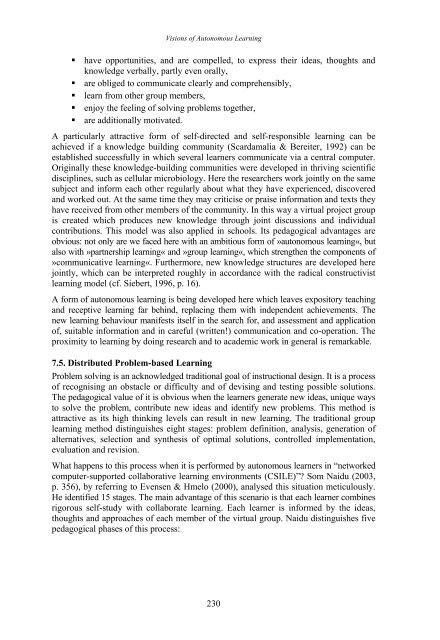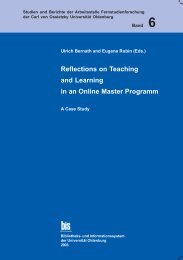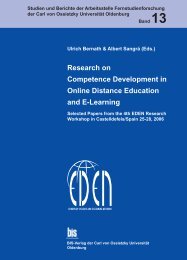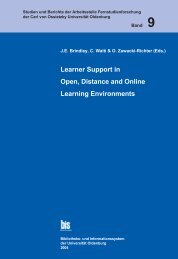Distance Education in Transition - Master of Distance Education ...
Distance Education in Transition - Master of Distance Education ...
Distance Education in Transition - Master of Distance Education ...
You also want an ePaper? Increase the reach of your titles
YUMPU automatically turns print PDFs into web optimized ePapers that Google loves.
Visions <strong>of</strong> Autonomous Learn<strong>in</strong>g<br />
� have opportunities, and are compelled, to express their ideas, thoughts and<br />
knowledge verbally, partly even orally,<br />
� are obliged to communicate clearly and comprehensibly,<br />
� learn from other group members,<br />
� enjoy the feel<strong>in</strong>g <strong>of</strong> solv<strong>in</strong>g problems together,<br />
� are additionally motivated.<br />
A particularly attractive form <strong>of</strong> self-directed and self-responsible learn<strong>in</strong>g can be<br />
achieved if a knowledge build<strong>in</strong>g community (Scardamalia & Bereiter, 1992) can be<br />
established successfully <strong>in</strong> which several learners communicate via a central computer.<br />
Orig<strong>in</strong>ally these knowledge-build<strong>in</strong>g communities were developed <strong>in</strong> thriv<strong>in</strong>g scientific<br />
discipl<strong>in</strong>es, such as cellular microbiology. Here the researchers work jo<strong>in</strong>tly on the same<br />
subject and <strong>in</strong>form each other regularly about what they have experienced, discovered<br />
and worked out. At the same time they may criticise or praise <strong>in</strong>formation and texts they<br />
have received from other members <strong>of</strong> the community. In this way a virtual project group<br />
is created which produces new knowledge through jo<strong>in</strong>t discussions and <strong>in</strong>dividual<br />
contributions. This model was also applied <strong>in</strong> schools. Its pedagogical advantages are<br />
obvious: not only are we faced here with an ambitious form <strong>of</strong> »autonomous learn<strong>in</strong>g«, but<br />
also with »partnership learn<strong>in</strong>g« and »group learn<strong>in</strong>g«, which strengthen the components <strong>of</strong><br />
»communicative learn<strong>in</strong>g«. Furthermore, new knowledge structures are developed here<br />
jo<strong>in</strong>tly, which can be <strong>in</strong>terpreted roughly <strong>in</strong> accordance with the radical constructivist<br />
learn<strong>in</strong>g model (cf. Siebert, 1996, p. 16).<br />
A form <strong>of</strong> autonomous learn<strong>in</strong>g is be<strong>in</strong>g developed here which leaves expository teach<strong>in</strong>g<br />
and receptive learn<strong>in</strong>g far beh<strong>in</strong>d, replac<strong>in</strong>g them with <strong>in</strong>dependent achievements. The<br />
new learn<strong>in</strong>g behaviour manifests itself <strong>in</strong> the search for, and assessment and application<br />
<strong>of</strong>, suitable <strong>in</strong>formation and <strong>in</strong> careful (written!) communication and co-operation. The<br />
proximity to learn<strong>in</strong>g by do<strong>in</strong>g research and to academic work <strong>in</strong> general is remarkable.<br />
7.5. Distributed Problem-based Learn<strong>in</strong>g<br />
Problem solv<strong>in</strong>g is an acknowledged traditional goal <strong>of</strong> <strong>in</strong>structional design. It is a process<br />
<strong>of</strong> recognis<strong>in</strong>g an obstacle or difficulty and <strong>of</strong> devis<strong>in</strong>g and test<strong>in</strong>g possible solutions.<br />
The pedagogical value <strong>of</strong> it is obvious when the learners generate new ideas, unique ways<br />
to solve the problem, contribute new ideas and identify new problems. This method is<br />
attractive as its high th<strong>in</strong>k<strong>in</strong>g levels can result <strong>in</strong> new learn<strong>in</strong>g. The traditional group<br />
learn<strong>in</strong>g method dist<strong>in</strong>guishes eight stages: problem def<strong>in</strong>ition, analysis, generation <strong>of</strong><br />
alternatives, selection and synthesis <strong>of</strong> optimal solutions, controlled implementation,<br />
evaluation and revision.<br />
What happens to this process when it is performed by autonomous learners <strong>in</strong> “networked<br />
computer-supported collaborative learn<strong>in</strong>g environments (CSILE)”? Som Naidu (2003,<br />
p. 356), by referr<strong>in</strong>g to Evensen & Hmelo (2000), analysed this situation meticulously.<br />
He identified 15 stages. The ma<strong>in</strong> advantage <strong>of</strong> this scenario is that each learner comb<strong>in</strong>es<br />
rigorous self-study with collaborate learn<strong>in</strong>g. Each learner is <strong>in</strong>formed by the ideas,<br />
thoughts and approaches <strong>of</strong> each member <strong>of</strong> the virtual group. Naidu dist<strong>in</strong>guishes five<br />
pedagogical phases <strong>of</strong> this process:<br />
230





